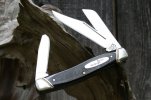- Joined
- Dec 24, 2016
- Messages
- 256
This is a question that’s been noodling around in my mind lately. How is the reverse tanto blade shape (ie: Benchmade 810 or 940) stronger than say a drop point or a wharncliff. Does it have to do with how all the angles on the blade meet in a more obtuse tip? Or does it have more to do with the blade steel used? Perhaps there's an explanation I haven’t even thought of yet I just don’t know. Until recently I’ve just chalked it up to wizardry and left it at that. But, of course, the planets aligned or the wind changed direction and now it’s a question stuck in my head.
“Help me, Obi-wan Kenobi! You’re my only hope!”
“Help me, Obi-wan Kenobi! You’re my only hope!”


